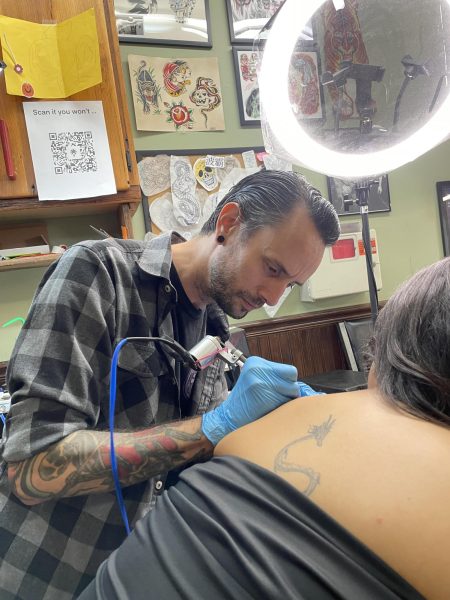Transgendered face multitude of challenges
November 1, 2017
One of the most controversial topics in our schools today is the allowance of transgendered students into their correct bathrooms and locker rooms. As laws and legal challenges have arisen across there was controversy at schools throughout McHenry County. Many students and parents responded with statements like, “Well, maybe I feel like a girl today, I’m going to go change in the girl’s locker room” or “I’m too scared to let my daughter go to school, she might get sexually harassed by the transgendered students while changing.” While the blatant over-sexualizing of under-aged students changing into PE uniforms is disturbing, these comments bring to light a much larger issue. The truth is that a large amount of the public still have no idea what it’s like to be transgendered and no concept of the trials faced by them on a daily basis.
To start with the faulty argument that someone can “feel like a girl/boy today,” I’d like to explain the concept of gender dysphoria. Gender dysphoria is defined as: “A conflict between a person’s physical or assigned gender and the gender with which he/she/they identify” by the American Psychological Association. To elaborate, they state; “People with gender dysphoria may often experience significant distress and/or problems functioning associated with this conflict between the way they feel and think of themselves (referred to as experienced or expressed gender) and their physical or assigned gender.” That is the main difference between being cisgendered (people whose gender identity matches the sex that they were assigned at birth) and transgendered, whether or not you experience gender dysphoria. Being transgendered does not mean waking up one morning, or every morning, and making the active or willing decision to be the other gender. Gender dysphoria is a diagnosable psychiatric disorder just like depression or anxiety and left untreated, gender dysphoria will often lead to serious self-harming behaviors.
So, let’s say we have gender dysphoria. What might be next?
The process of changing your sex is known throughout the transgender community as “transitioning.” Transitioning has two stages that are usually overseen by a gender therapist or psychiatric professional. Many doctors will not help transgendered people until they have a note from a gender therapist, so there goes waking up and suddenly being a girl for the day. The first stage is the administration of sex hormones. These hormones do not affect the temperament, sex drive, or aggressiveness of the individual. They are legally prescribed by a medical doctor and are only enough to elevate either the testosterone (‘T’ for short) or estrogen (‘E’ for short) hormones to levels that would be naturally found in people who were born male or female.
In people who are male-to-female (MTF) transgendered, these hormones will cause breast growth, an increase in the pitch of their voice, the redistribution of fat to and from certain areas of the body (i.e. hips, thighs, arms and legs,) for people with hair on their chests, backs, and faces, the hair will thin, but may not go away altogether. On top of all of this, there are also the emotional reactions that I have seen many of my friends go through as their bodies make these drastic changes. Many people refer to hormone therapy as a second puberty.
In people who are female-to-male (FTM) transgendered, there is a practice known as “binding’” in which the person uses chest binders to flatten their breasts so that they appear more masculine. If done incorrectly, this can cause an array of medical issues that can affect person later when they possibly elect to have surgery. In fact, until very recently there were no relevant medical studies about the long-term effects of chest binding. We now know that binding incorrectly or for too long of a time period can lead to fractured or compressed ribs, collapsed lungs, and severe back pain. Despite these risks, chest binding is still an extremely common practice among transgender men because there are simply no other alternatives available to them. On top of that, hormone therapy will sometimes cause breast pain, it will cause fat redistribution, weight gain, a gain in muscle definition, some people may experience hair growth on their backs, chests, and faces.
The second stage would be surgical. Surgery for both FTM and MTF transgendered people can consist of top surgery and bottom surgery. These surgical procedures are extremely costly and almost never covered entirely by insurance. Top surgery for a female-to-male is called a Subcutaneous Mastectomy, and involves the removal of breast tissue. This surgery usually costs from $3500-$9000. Bottom surgery for FTM transgendered people starts with a hysterectomy (removal of the uterus) and bilateral salpingo-oophorectomy (removal of the fallopian tubes and ovaries) costing roughly $11,000. Then once the female reproductive organs are removed, a genital reconstructive procedure is performed. The skin for this procedure is usually taken for the remaining female genitals or is grafted from the hip or arm. For MTF people, top surgery usually implies breast implants which cost about $8,000. Bottom surgery consists of the removal of the testicles and the inversion of the penis costing about $10,000.
So now that you know the lengths that transgendered people go through to feel comfortable in their own bodies, next time you hear someone make an inappropriate joke or a rude comment — be a good ally — correct them. Educate them. Hatred and discrimination spring from fear, and fear comes from misunderstanding, so the most meaningful thing that a person can do to help is to educate others.











